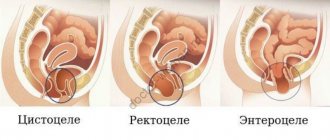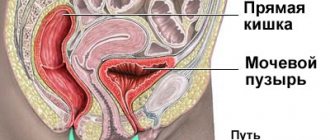Causes of bladder inflammation: bacterial and non-bacterial cystitis
The content of the article
When we talk about bladder inflammation, we primarily mean cystitis caused by the proliferation of bacteria in the urine - bacterial cystitis. But there are other forms of cystitis, provoked by non-bacterial and non-infectious causes. Their symptoms are very similar to true bacterial cystitis, however, their main feature is that they are not associated with an increase in the number of dangerous bacteria in the urine and bladder.
For example, ordinary hypothermia - hypothermia - can lead to the appearance of symptoms of cystitis. Low temperature irritates the bladder receptors located at the very bottom of the pelvis and weakens the natural immunity of the urethral mucosa. Under this condition, bacteria can attack the bladder by entering the genitourinary tract from outside. Those. non-bacterial cystitis can easily become bacterial.
The patient may also develop:
- Fungal cystitis
, which is a type of infectious cystitis. Its cause is a fungal infection; - Post-radiation cystitis
. May occur years after pelvic radiation; - Venereal cystitis.
Inflammation of the bladder caused by sexually transmitted agents. They are not detected during routine bacteriological examination of urine; additional analysis is required to identify them. - Overactive bladder
. Cystitis associated with bladder irritation, for example due to sand in the bladder. Significant mental stress can lead to similar signs of bladder dysfunction. The condition can also be caused by an enlarged prostate gland in men, although an overactive bladder can also develop without a significant enlargement of the prostate gland.
Acute cystitis
It is worth noting that the treatment of acute cystitis always involves bed rest. Treating the inflammatory process in the bladder “on the run” without issuing a sick leave, especially in the cold season, means risking the possible transition of the disease to a chronic form. The disease is always accompanied by severe stress for the body, which requires rest and rest. At the same time, ignoring the disease and postponing a visit to the doctor can “result” in pyelonephritis, the treatment of which will require constant medical supervision.
More information about drug treatment of cystitis in women: drugs
Some of these drugs are commonly prescribed:
"Monural". This drug has an antibacterial effect on most gram-positive bacteria. The main active ingredient of the drug is fosfomycin. "Monural" is prescribed starting from the age of five, and is contraindicated in cases of severe renal failure.
Furagin. An antimicrobial drug that is well tolerated by patients. It effectively fights the action of many harmful microorganisms, including staphylococci and E. coli. Please note that Furagin has contraindications, including pregnancy and renal failure.
Antibiotics and quinolones. These medications for cystitis in women have a wide spectrum of action, so they are prescribed not only for the treatment of cystitis and effectively fight a number of STIs, streptococci, and staphylococci. Use only after prior consultation with a doctor.
Monurel. This remedy is usually prescribed as a preventive measure (especially in the case of frequent exacerbations of the disease). The main active ingredient is cranberry extract, which suppresses the action of microbes in the walls of the bladder.
Cyston. Belongs to the category of herbal preparations. The composition includes a complex of ten plants (didimocarpus cauliflower, membranous rash, madder cordifolia, saxifraga reed and others) that help relieve inflammation during female cystitis. Has antispasmodic and diuretic effects.
Cardiologist German Gandelman on the causes of female cystitis. Source - cystis.ru
Treating cystitis at home can be very effective. Of course, home treatments do not exclude visiting a doctor and the need for tests, but they will help relieve unpleasant symptoms and pain.
Bearberry decoction shows excellent effectiveness, which is confirmed by experienced nephrologists. This herb has a diuretic effect and effectively removes “bad” flora from the bladder.
Cranberry juice is also recommended for use, which, due to its acidic environment, prevents the proliferation of microorganisms. At the first manifestations of cystitis symptoms, you can take a decoction of lingonberries, bear's ear, and half-palm.
Diet
In order to relieve inflammation as quickly as possible, it is recommended to drink plenty of fluids: the minimum volume of liquid consumed should be 1.5 liters per day.
It is also necessary to follow a diet.
Nutrition for cystitis has a number of restrictions. Eliminating hot and spicy foods will promote recovery and help avoid a recurrence of the situation. During the treatment period, it is necessary to completely avoid alcohol. This applies to all alcohol-containing drinks.
If you notice painful and frequent urination, blood, flakes or pus in your urine, do not rush to panic. Indeed, according to statistics, female cystitis is a very common phenomenon.
The main thing is not to delay and consult a doctor in time.
Sources:
- ISSUES OF DIFFERENTIAL DIAGNOSIS AND TREATMENT TACTICS OF ACUTE UNCOMPLICATED CYSTITIS IN WOMEN IN PRIMARY CARE. Akilov F.A., Arustamov D.L., Alidzhanov Zh.F., Rakhmonov O.M., Mirkhamidov D.Kh. // Bulletin of emergency medicine. – 2011. – No. 1. – P.106-110.
- CURRENT ASPECTS OF PHARMACOTHERAPY OF CHRONIC CYSTITIS IN THE ACUTE STAGE IN WOMEN. Kurnosova N.V., Kuzmenko A.V., Kuzmenko V.V. // Saratov Scientific and Medical Journal. – 2010. – No. 3. – pp. 705-708.
- Diagnosis and treatment of interstitial cystitis. Zaitsev A.V. // Author's abstract. dis. Dr. med. Sci. M. - 1999. P. 38.
- Results of studying the prevalence of antibiotic resistance among pathogens of community-acquired urinary tract infections. Sidorenko S.V., Ivanov D.V. // Antibiotics and chemotherapy. - 2005. No. 5091. - P. 3-10.
- Uncomplicated and complicated urinary tract infections. Principles of antibacterial therapy. Lopatkin N.A.. Derevyanko I.I. // Russian medical journal. - 1997. - T. 5, No. 24. P. 1579-1589.
- https://www.pubfacts.com/detail/23276554/Treatment-of-interstitial-cystitis-in-women
- https://www.researchgate.net/publication/44614433_Bacterial_cystitis_in_women/link/0c960517f54b1f402…
- https://www.aafp.org/afp/2009/0315/p503.html
- https://www.healthline.com/health/cystitis
Epidemiology and clinical picture of cystitis
Classic bacterial cystitis is a disease that primarily affects women due to the specific structure of the lower genitourinary tract: a short urethra and the proximity of the bacterial flora of the vagina and intestines.
According to statistics:
- About 15% of adult women develop cystitis at least once a year;
- Almost two thirds of women experience bladder inflammation at least once in their lives.
- Of these two-thirds, 25% suffer from recurrent bladder infections.
You can get cystitis very simply, for example, by standing barefoot on a cold tile in the bathroom. The clinical picture may be caused by irritating foods and carbonated or alcoholic drinks.
Cold tile
Symptoms of cystitis develop relatively quickly. First signs:
- Frequent, painful urination with small amounts of urine. Often patients note that only a few drops are released.
- Burning when urinating;
- The appearance of a few drops of blood at the end of urination;
- Pain or cramping in the lower abdomen above the pubic bone;
- Body temperature is usually not elevated, and if present, it does not exceed 37.5 ° C.
Painful urination
Low temperature
Examination of the patient usually shows weak sensitivity in the lower abdomen, in the central part, that is, in the projection of the bladder itself.
Cystitis: symptoms
Cystitis manifests itself as pain in the lower back and lower abdomen, accompanied by a very frequent urge to urinate, burning or acute pain when urinating. The color of the urine changes, it becomes cloudy, and sometimes blood appears in it. Possibly general malaise, fever and chills. Cystitis can also be asymptomatic, revealing its presence during testing.
Bladder infection in men
Although bladder infections are more common in women, men also get cystitis.
Signs and symptoms of bladder infection (cystitis) in men:
- Frequent urination;
- A strong and constant need to urinate (urgency);
- A burning or tingling sensation when urinating or immediately after urinating (dysuria);
- Low temperature;
- Cloudy urine with a strong odor;
- Presence of blood in the urine (hematuria);
- Problems with urination, especially if there are problems with the prostate.
Blood in the urine
Disorders that may be associated with an increased risk of bladder infection in men include the following:
- Enlarged prostate (benign prostatic hyperplasia);
- Stones in the kidneys;
- Abnormal narrowing of the urethra (urethral stricture);
- Recent urinary tract procedure: insertion of a tube to drain the bladder (catheterization) or insertion of a small camera to examine the bladder and urethra (cystoscopy).
Not to the pharmacist, but to the doctor!
When customers at a pharmacy ask a pharmacist to sell them “something for cystitis,” they often do not understand that they are doing it to their detriment. After all, this disease (if it really is one) can be different. For example, cystitis can be primary and secondary (that is, arising on its own or as a result of another disease). It can also be infectious and non-infectious. In one case, it is caused by microbes, and in another, inflammation of the bladder mucosa may be associated, for example, with allergies, medications, chemical or thermal damage. In addition, cystitis can be acute and chronic.
In each of these cases, treatment must be strictly individual. And even infectious cystitis can be treated with different drugs, depending on the microbe that caused the infection. An incorrectly chosen medicine or an incorrectly selected dose will lead, at a minimum, to ineffective treatment, and at maximum, to the development of antibiotic resistance in microbes. For this reason, it will be extremely difficult to subsequently cope with microbial inflammation. In addition, such pseudo-treatment can transform acute cystitis into chronic, which is much more difficult and expensive to identify and treat. Therefore, the first rule for cystitis is no self-medication!
Diagnosis of cystitis
A definitive diagnosis cannot be made solely on the basis of symptoms and physical examination; urine sediment examination is necessary. The diagnosis of cystitis is confirmed if, together with the above-mentioned signs of the disease, an increased number of leukocytes is detected in the urine.
Patients are prescribed:
- general and bacteriological urine tests;
- general blood analysis;
- smear for infections from the urethra;
- Ultrasound of the pelvis with a detailed examination of the bladder.
In difficult cases, cysto- and urethroscopy is performed.
It's time to start an investigation
But sometimes even treatment according to all the rules does not help. Therefore, if cystitis has not gone away within 7 days, it is necessary to undergo further examination, and, perhaps, begin to actively look for concomitant diseases. Among them may be, for example, other diseases of the genitourinary system (such as colpitis, bacterial vaginosis, pyelonephritis, urolithiasis, prostatitis in men), as well as genital infections (trichomoniasis, chlamydia). Patients with diabetes mellitus are also predisposed to cystitis (“sweet” urine promotes the growth of bacteria).
To identify the circle of “suspects,” the doctor must collect an anamnesis. And for this, you need to find out whether cystitis occurred for the first time or not, whether there was hypothermia before the exacerbation, whether all this was preceded by unprotected sex, whether the patient underwent aggressive treatment (chemotherapy, radiation therapy), whether he took medications and what kind, etc.
Depending on this, the doctor can refer the patient to a gynecologist and urologist, and also prescribe a list of necessary studies. As a rule, for chronic cystitis, the following are necessary: ultrasound of the pelvic organs and invasive cystoscopy (a tube with light is inserted into the urethra, and the condition of the mucous membrane is assessed).
Among the tests, you may need a urine sample according to Nechiporenko (helps to exclude or confirm the diagnosis of “pyelonephritis”) and the so-called two-glass urine sample (needed to make a differential diagnosis between cystitis and urethritis).
Proper treatment of cystitis
Despite the fact that cystitis may gradually fade away on its own, it is necessary to treat all inflammations of the bladder that lead to the appearance of symptoms and the growth of bacteria in the urine. The infection can spread to neighboring organs, cause complications, and become chronic.
It is especially important to treat:
- Men and women with a significant amount of bacteria in their urine - > 100,000 (more than 10 out of 5) bacteria in one milliliter of urine;
- Patients with weak immunity;
- Patients with recurrent cystitis;
- Patients with venereal cystitis;
- Pregnant women;
- Patients undergoing urological, orthopedic or gynecological surgery;
- Patients before organ transplantation.
The goal of treatment for bacterial cystitis is abstinence, that is, “sterilization” of urine, and elimination of symptoms of bladder inflammation. Thus, the first choice drugs, depending on the results of the urine test, are nitrofurantoin, co-amoxiclav, cephalexin or norfloxacin.
Treatment of cystitis
These drugs are also used to treat and prevent recurrence of cystitis during pregnancy. But nitrofurantoin should not be used during the last three months of pregnancy. In pregnant women, urine cultures should be checked 14 days after treatment.
Why it is not recommended to treat cystitis at home
The onset of cystitis occurs quickly, so most often patients begin treatment on their own and perhaps even improve.
It is important to remember that the disease does not stop once the symptoms disappear.
If the disease is not treated, it can become chronic. The inflammatory process can take an upward path and even cause pyelonephritis.
Prevention of cystitis
Before and after sexual intercourse, you need to wash your genitals. You should constantly empty your bladder. Treat all diseases of the genitourinary system completely. Don't get too cold.
By correctly following all the above recommendations and listening to your doctor, you can forget about cystitis after 7-10 days. For our part, we are ready to do whatever is required for this.
In our clinic you can undergo all the necessary tests and examinations on site. The doctor will prescribe modern treatment that is adequate to your condition and taking into account your wishes. We care about your health and well-being and will be happy to help!
MAKE AN APPOINTMENT
Follicular cystitis
A rare form of chronic inflammation can be considered follicular cystitis, in which the accumulation of lymphocytes occurs in lymphoid follicles located in the mucous membrane and underlying layers of the bladder wall. Follicular cystitis most often affects women and manifests itself similarly to other chronic cystitis with painful urination with frequent urge. The diagnosis is established by the results of a biopsy [12].
The exact cause of the disease is unknown, but it is often associated with long-term or repeated urinary tract infections. Follicular cystitis may also be found adjacent to invasive or localized bladder malignancies, representing a host response to the tumor. Rare cases have been identified after radiation and chemotherapy of the pelvic organs [12].
Treatment is usually conservative. They use hormonal and non-hormonal anti-inflammatory drugs, antibiotics, vitamins, and follow-up monitoring [12].
- Bibliography:
- * As part of complex therapy, Fitolysin® Paste for the preparation of a suspension for oral administration relieves pain in cystitis caused by inflammation and spasm, due to its anti-inflammatory and antispasmodic effect, and relieves frequent urges due to its antispasmodic effect.
- Khalilova U.A., Skvortsov V.V. et al. Cystitis. Nurse. 2018; 6:6-11. https://doi.org/10.29296/25879979-2018-06-02
- Clinical recommendations. Cystitis. Year of approval 2016.
- Instructions for use of the drug PHYTOLYSIN® Paste for the preparation of a suspension for oral administration.
- Onopko V.F., Kirilenko E.A. et al. Interstitial cystitis or painful bladder syndrome: a modern view of the problem. Bulletin of the All-Russian Scientific Center SB RAMS, 2016; 1 (107): 65-69.
- W Donald Cooke, Abigail J Tarr Cooke. Successful treatment of eosinophilic cystitis with benralizumab. Urol Case Rep. 2022 Aug 11; 33: 101379. doi: 10.1016/j.eucr.2020.101379. eCollection 2020 Nov.
- Anaev E.Kh., Chuchalin A.G. Pulmonary eosinophilia: diagnosis, approaches to therapy. Pulmonology. 20212; 4: 106-115.
- PC Verhagen, PG Nikkels, TP de Jongc. Eosinophilic cystitis. Arch Dis Child. 2001 Apr; 84 (4): 344-6. doi: 10.1136/adc.84.4.344.
- Instructions for medical use of the drug Ketamine. Encyclopedia of drugs radar. https://www.rlsnet.ru/tn_index_id_1712.htm (access date 08/31/2021).
- Nancy A. Melville. Ketamine Linked to Bladder Toxicity. Psychiatry News. March 28, 2016. https://www.medscape.com/viewarticle/861056
- Laurent O.B., Sinyakova L.A. et al. Hemorrhagic cystitis in women: epidemiology, etiology, pathogenesis, diagnosis. Consilium Medicum. 2017; 19 (7): 50–55. DOI: 10.26442/2075-1753_19.7.50-55
- Kaprin A.D., Kostin A.A. et al. Experience with the use of the drug Ingaron® (human interferon gamma recombinant) in the treatment of radiation cystitis accompanied by hematuria. Pharmateka. 2013; 12:40-43.
- Mark Trombetta, Matthew Packard et al. The use of radiotherapy in the management of follicular cystitis refractory to conservative and surgical management. Rare Tumors. 2012 Apr 12; 4(2):e25. doi: 10.4081/rt.2012.e25. Epub 2012 May 18.
How does infection occur?
Anatomically, women have a much higher risk of developing cystitis, and a man can be an asymptomatic carrier of bladder inflammation from one woman to another. Whether cystitis will be transmitted will depend on the state of the person’s immune system. But the likelihood of getting sick is higher in people who often change partners or have several parallel contacts. Since one of the causative agents of cystitis is E. coli, failure to comply with the rules of hygiene after sex can become a factor in the infection of a woman and subsequent infection of a man.
Barrier protective methods, especially a condom, significantly reduce the risks of transmission of both STIs and opportunistic microflora that cause cystitis, but, unfortunately, do not completely eliminate it.
Cystoscopy and cystography for cystitis
If cystitis is suspected, doctors often use instrumental diagnostic techniques.
For example, in modern medical practice cystoscopy and cystography are often used.
Cystoscopy refers to the examination of the bladder cavity using a special tube equipped with a video camera at the end.
Thanks to the video camera, the doctor can evaluate with his own eyes various changes in the bladder.
The cystoscope is inserted through the urethra.
The procedure is quite unpleasant and can be performed under anesthesia.
But sometimes you cannot do without it, and therefore it is not recommended to refuse it if there are suspicious symptoms.
Another effective diagnostic method is cystography.
In this case, a special contrast agent is injected into the bladder, after which an X-ray image is taken.
In the resulting image, the doctor can see various defects in the filling or distribution of contrast and monitor the process of its removal.
Both methods are widely used in urological practice.
Since they have proven themselves to be effective in diagnosing cystitis and a number of other diseases of the genitourinary system.
Cystitis in women: causes
To cure a disease, you need to know what causes inflammation. The main cause of cystitis is bacteria that have entered the urinary system and caused an inflammatory process. In 90% of cases women are affected by:
- The female urinary canal is wider and shorter than the male one, and because of this, bacteria enter the bladder freely.
- The location of the urethra in close proximity to the anus, from which E. coli can enter.
Statistics have shown that approximately a quarter of women have experienced cystitis, and approximately ten percent have a chronic form of the disease. In the male population the figure is much lower. And yet the question of what causes illness is no less relevant.
Other causes
There are many reasons for the development of cystitis. Here are some of them:
Infection. In most cases, it is the infectious agent in the urinary canals that gives rise to the development of cystitis, since the pathogenic flora enters the ureter from the anus. Such exposure can occur due to long exposure to the cold and reduced immunity and occurs in 90% of cases of the disease. In other cases, the infection enters through other means, for example, from the kidneys. In very rare cases, infection occurs through the bloodstream or lymph.
Side effects of medications. Some medications have side effects when taken that lead to inflammation in the ureter. Such drugs, for example, are cytostatics prescribed for the treatment of cancer.
Allergic reaction. Sometimes an allergy manifests itself as swelling of the mucous membrane of a woman’s genitourinary tract. The main method of treatment is to identify the allergen and avoid contact with it.
Related factors
It is necessary to know how the disease manifests itself and begins in order to begin treatment in a timely manner. There are also factors that increase the chance of cystitis:
- Pressure. Wearing tight underwear made of synthetic fabric, in which bacteria multiply more actively, increases the likelihood of developing the disease.
- Sexual relationships with many partners. Unprotected contacts and constant changing of partners are a common cause of cystitis.
- Intestinal diseases and fecal stagnation. Because of this, pathogenic bacteria in the intestinal flora are activated.
- Kidney diseases. Such diseases increase the risk of infection occurring and spreading.
- Hormonal imbalance. The endocrine system may play a significant role in urinary problems. For example, cystitis often occurs in diabetics.
- Low immunity. With a weak immune system, infections quickly spread throughout the body.
In addition to all the above reasons, there is also one more that most women are not even aware of. We are talking about sexual contact with both regular and different partners.
Cystitis in women after intimacy (postcoital)
The disease occurs or worsens after sex. Its causes are poor hygiene, the presence of STDs (sexually transmitted diseases) in a partner, as well as other factors.
Attention. 60% of genitourinary tract infections occur after sexual intercourse. Every sexual contact increases the risk of infection by 100%.
Unprotected (without a condom) sex often leads to the development of the inflammatory process. If a woman has reduced immunity, infection occurs. A bacterium, virus, or protozoa travels through the bloodstream, lymph, or due to insufficient hygiene from the vagina into the urethra, and from there, along the ascending path, into the bladder.
What is postcoital psychosomatic cystitis
The cause of postcoital inflammation of the bladder can be suppressed sexuality, negative emotions and experiences. We are talking about a disease of a non-infectious nature, in which symptoms similar to ordinary cystitis occur.
Exacerbation often occurs after intimacy. Therefore, when treating postcoital cystitis, it is necessary to exclude the psychogenic factor. Psychologists are confident that the disease is provoked by anxiety and guilt, so treatment must be comprehensive.
It is necessary to remove excess nervous tension, work with childhood psychotraumas, help the patient understand emotions and raise their own self-esteem. The psychologists at our clinic “Leib-Medic” do an excellent job with this.
Is it possible to transmit cystitis from another person?
The question of whether the infection is transmitted from man to woman is of interest to many women if their partner is sick. Since cystitis in most cases is infectious in nature, and bacteria are actively excreted in the urine, they are transmitted through sexual contact with the subsequent development of inflammation.
If a woman has a reduced immune system or, for example, during pregnancy, when due to hormonal activity the body reacts too sharply to everything, infectious agents - viruses, bacteria - multiply quickly and can enter the bladder with the blood or through the genitourinary tract.
Attention. Unprotected sexual contact with a man who is sexually active is especially dangerous. Changing partners like gloves, he contributes to the active spread of infections.
You can become infected not only during intimacy, but also if you use shared hygiene items, for example, towels. So the answer to the question of whether it is possible to become infected from a woman suffering from cystitis is positive.
Ultrasound for cystitis
Ultrasound examination is perhaps rightfully considered a classic method.
Used for various pathologies of the urogenital system, as well as the reproductive organ system.
The method not only provides good diagnostic data, making it possible to cope with the diagnosis even in quite complex cases.
But it is also so harmless that it can be performed without restrictions even by pregnant women and children.
Ultrasound in children is also widely used precisely due to its harmlessness.
For a number of patients, this technique is perhaps the only one allowed.
Since it has practically no contraindications for implementation.
During an ultrasound for cystitis, the doctor assesses the shape of the bladder, looks at the fullness of the organ, and pays attention to various defects in the outline.
However, often an ultrasound examination alone is not enough to diagnose cystitis.
Still, you will have to confirm the results using additional methods, including laboratory ones.
Indeed, it is often not immediately possible to identify long-term serious changes.
And it’s quite difficult to determine their cause in order to start therapy.
Eosinophilic cystitis
Eosinophilic cystitis is a rare form of interstitial cystitis in which eosinophils accumulate in the bladder tissue. As with other forms of interstitial cystitis, it can be accompanied by distressing symptoms: frequent urgency, painful urination, urinary incontinence, blood in the urine, and pelvic pain [5].
Eosinophils are a type of white blood cell. There are diseases and conditions in which the content of eosinophils in peripheral blood and tissues increases, which is called eosinophilia. Moreover, in tissues the level of eosinophils becomes several hundred times higher than in the blood. Their maximum number is found in the epithelium of the mucous membranes of the respiratory, gastrointestinal and genitourinary tracts [6].
Long-term eosinophilia can lead to tissue damage. The cause of the disease is largely unknown, although some cases have been attributed to medications, infection, bladder trauma, food allergens, and catheterization. Treatment is empirical. It consists of removing any suspected allergen. To relieve symptoms, pharmacological medications include corticosteroids, anticholinergic and antiallergic drugs, antispasmodics, antibiotics, leukotriene antagonists, and immunosuppressants. In severe cases, surgery may be required. Treatment of eosinophilic disorders has recently improved with the advent of monoclonal antibody drugs [5, 7].
Diagnosis of urological disease
Making a diagnosis for acute cystitis is usually not difficult. The doctor evaluates the clinical manifestations of the disease and prescribes a urine test, which is an additional way to confirm the diagnosis. First, a general urine test is performed, after which a microflora culture is done, which allows you to select the right drugs for the treatment of cystitis. [12]
But the diagnosis of the disease in women has some peculiarities. Therefore, in order to prescribe the correct treatment for acute cystitis, doctors carry out differential diagnosis. [20] Symptoms of dysuria, suprapubic pain, imperative urge to urinate can be caused by a number of processes of non-infectious and infectious origin [21]:
- Inflammatory diseases of the pelvic organs. Accompanied by pain in the lower abdomen and pelvic area, mucopurulent endocervical discharge.
- Overactive bladder. The clinical picture includes nocturia and urinary urgency. Often accompanied by depression, sexual dysfunction, and psychological disorders that lead to urinary incontinence.
- Urethritis. The disease occurs in sexually active women. It can be caused by herpes simplex virus, trichomonas, chlamydia, Candida fungi, and gonococci. In some cases, urethritis occurs due to the use of contraceptive gel.
- Interstitial cystitis (painful bladder syndrome). Accompanied by a reduction in bladder volume, imperative/frequent urination, and dysuria.
In a number of clinical cases in patients with dysuria and the presence of profuse vaginal discharge, which is accompanied by itching and odor, doctors consider the diagnosis of vaginitis. It is often caused by intestinal flora, Trichomonas, and yeast-like fungi. [21]











